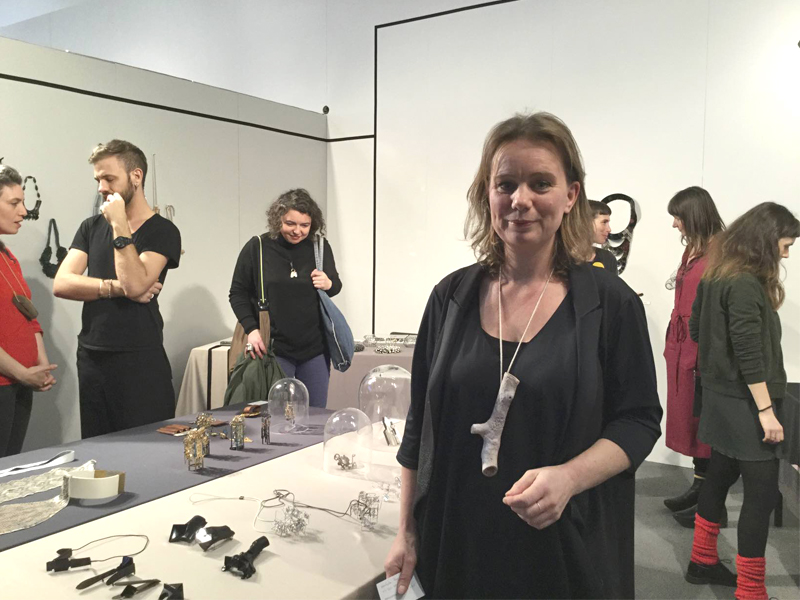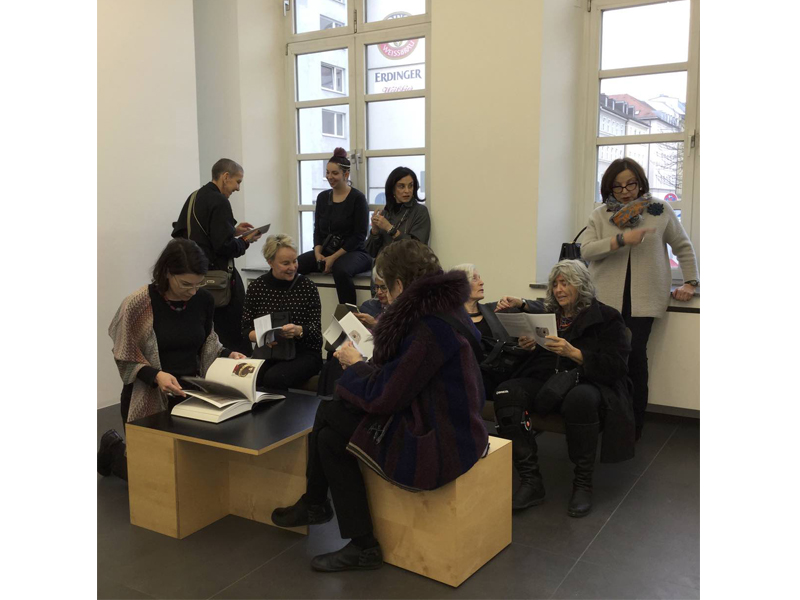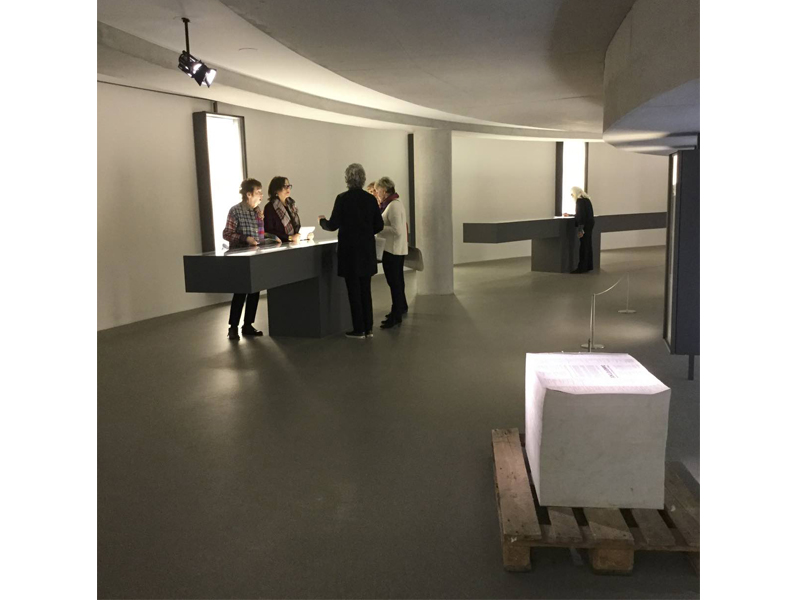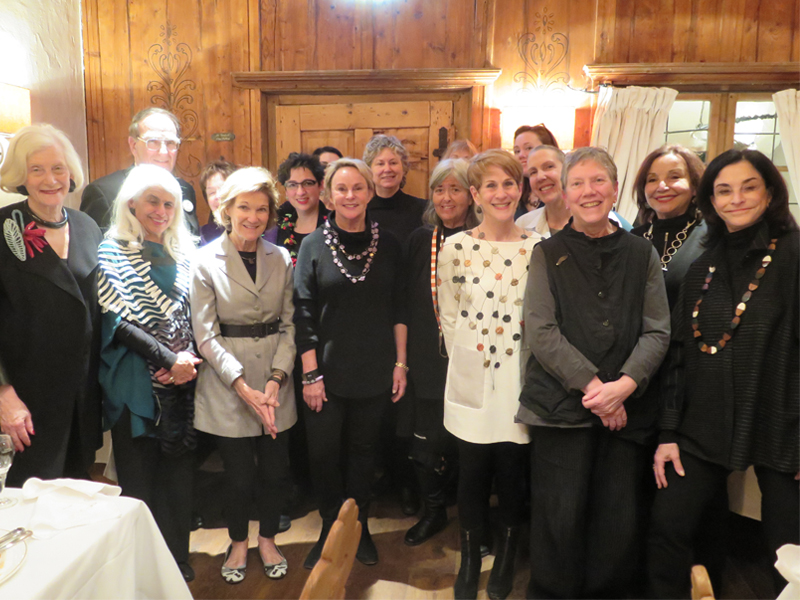
Camaraderie, collecting, and competition were the watchwords for the AJF group that traveled to Munich for this year’s Munich Jewelry Week. We traveled together from Wednesday, March 8, to Saturday, March 11, 2017. The lovely Charles Hotel served as our base.
The annual event takes place at a convention center, the Internationale Handwerksmesse (known as the “Messe”), and is the major event in the field of contemporary art jewelry. Founded in 1959 by industry luminary Herbert Hofmann, it has become one of the most outstanding exhibitions on the global jewelry scene and a meeting place for collectors, gallery owners, museum curators, and jewelry artists from around the world. It’s organized by the Chamber of Crafts for Munich and Upper Bavaria, and sponsored by the Danner Foundation. Schmuck now encompasses exhibits at galleries, studios, and museums throughout the city. While our group made a valiant effort, there are so many that it isn’t possible to see them all!

Wednesday, March 8
After an enjoyable kick-off dinner the evening before, we got to the Messe bright and early on opening day and descended on galleries well known to AJF: Galerie Marzee, Platina, Galerie Ra, Galerie Rosemarie Jäger, ATTA Gallery, the Handshake collective, and Galerie Spektrum. In addition, the convention hall included jewelers and craftspeople from Germany and places far afield, and included clothing, goldsmiths, folk costumes, and more.

Each year the show pays homage to one artist. This year it was Renate Heintze, who was a teacher with Dorothea Prühl at Burg Giebichenstein and at the forefront of the studio jewelry movement. In addition to displaying some of Heintze and Prühl’s work, Galerie Marzee showed striking and dramatic work by established makers who had studied under each. The differences among the “student” works could be tied back to the teacher.
Among other things, Schmuck also includes two special juried shows. One is called Schmuck. For this year’s show, jurors winnowed down 700 submissions to 67 artists from 31 countries. The other show, Talente, focuses on emerging artists and featured 21 jewelry pieces from 15 countries.

We were treated to a special tour of Schmuck by the general manager, Wolfgang Lösche, and one of Talente with Dr. Michaela Braesel. It was very interesting to learn that even during the Cold War, when the Berlin Wall was standing, the Soviet Union allowed East German artists who were selected to participate in Schmuck.
Mid-afternoon, our next stop was Galerie Wittenbrink, with a show of Otto Künzli’s work called Quidam, which loosely translates as “just anybody,” or “just the ordinary.” Each piece showcased an eye of some sort, some of which had the Mona Lisa effect of following you around.

Thursday, March 9
We started the day with a thought-provoking roundtable conversation among AJF trip participants discussing how to support and expand interest in art jewelry. The field has slowly expanded over AJF’s 20 years of existence. Last November, the board decided to focus more on items of interest to collectors, thus the new monthly “On Offer” section of the website, where member galleries can showcase a piece, as well as the monthly “Report,” where members can post news of interest.
The conversation heightened awareness of the fact that we can all do our part to expand awareness and appreciation of the field.
We then went to the nearby Kunstpavillon for an installation show by several artists. All work was supposed to incorporate a chair or some aspect of seating.
After a delicious lunch at the popular Brenner restaurant, we bused over to a beautiful old building, Münchner Residenz, where makers Mari Ishikawa and Margit Jäschke showed their elegant and creative work.

At Galerie Wittenbrink, we viewed the work of Reinhold Ziegler and his installation, called Lust for Life. He comes from a family of goldsmiths and was trained as such, but at age 37 decided he wanted to do something else, so he retrained and reinvented himself as an art jeweler. This body of work included a trilobite fossil, a dinosaur egg, and a meteorite. As intriguing as those elements were, what took my breath away were the oxidized silver attachments created to attach the element to a cord.
Then on to Bavarian Hand Works to see Doris Betz’s exhibit, Jewellery and Drawing. She does amazing work hand-twisting wires then forming and joining them into necklaces and bracelets.
We ended the afternoon at Galerie Handwerkskammer, with an exhibit honoring Manfred Bischoff, who passed away a couple of years ago. Wolfgang Lösche, the general manager of Schmuck, spearheaded the show’s development, in which artists who had a relationship to Bischoff created work honoring him and reflecting his influence.
That evening, we made the trip back over to the Messe for a dinner with makers, gallerists, and others associated with Schmuck. It was a chance to talk in a festive setting. Stefano Marchetti received the Bavarian Prize.

Friday, March 10
We started the day at the Pinakothek der Moderne, the design museum, viewing the Danner collection in the Danner Rotunda. This assemblage of breathtaking art jewelry in 34 vitrines includes pieces from all over the world, beginning with avant-garde artists of the 60s through today. The collection is curated by Karl Fritsch, a well-respected maker himself. The collection includes pieces by Lisa Walker, Jiro Kamata, Gerd Rothmann, and Francesco Pavan, among many other well-known names.

We then climbed up a few floors to the press opening of the Tone Vigeland retrospective. Vigeland is one of the foremost Norwegian makers; she has been working in silver since the 60s. This is the first retrospective outside of Norway in decades. She was there walking the press and entourage, including us, through the exhibit of her flabbergastingly creative and meticulous silver work.
After lunch across the way at the Alte Pinakothek, the museum with the Old Masters, we visited many galleries, among them Galerie Spektrum, Galerie Biro, Jewelers’werk, and Maurer Zilioli. Works included established makers such as Georg Dobler and Peter Bauhuis, as well as emerging makers.
Saturday, March 10
In the morning, the group traveled outside of town to view exhibits by younger artists. I did not attend, but based on some of the jewelry purchased by our group, the makers were a talented lot.

The group lunched at a charming restaurant, Käfer Schänke, then moved on to the Villa Stuck, the elegant former home and studio of the painter Franz Stuck. The venue now houses temporary exhibits. Private Confessions was curated by Ellen Maurer Zilioli and encompassed drawings by well-known makers that illustrated their thought processes.
The next stop was a visit to the exhibit Pioneers of Czech Modern Jewellery, at the Czech Center. The Czechs were talented art jewelers, many of whom created dramatic silver and glass neckpieces and other jewelry. The work started in the 70s. The prices were reasonable because, as the curator Pavel Opočensky explained, the Czechs haven’t caught on to what they can charge in the Western world. Opočensky is a well-respected maker in his own right and was sporting an industrial-looking brooch of his own work that was fabulous.

Then back to the Messe for the announcement of the winners of the Hoffman Award, as well as the winner of AJF’s biannual Susan Beech Mid-Career Artist Grant. Cristina Filipe, from Portugal, was the grant recipient, for the publication and translation of a book on the history of Portuguese contemporary jewelry along with an accompanying retrospective exhibition.

Our farewell dinner was at the Munich landmark Spatenhaus.
Once again, a fabulous and memorable AJF trip.





